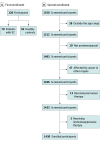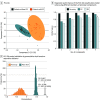Development and Validation of a Serum Metabolomic Signature for Endometrial Cancer Screening in Postmenopausal Women
- PMID: 32986110
- PMCID: PMC7522698
- DOI: 10.1001/jamanetworkopen.2020.18327
Development and Validation of a Serum Metabolomic Signature for Endometrial Cancer Screening in Postmenopausal Women
Abstract
Importance: Endometrial carcinoma (EC) is the most commonly diagnosed gynecologic cancer. Its early detection is advisable because 20% of women have advanced disease at the time of diagnosis.
Objective: To clinically validate a metabolomics-based classification algorithm as a screening test for EC.
Design, setting, and participants: This diagnostic study enrolled 2 cohorts. A multicenter prospective cohort, with 50 cases (postmenopausal women with EC; International Federation of Gynecology and Obstetrics stage I-III and grade G1-G3) and 70 controls (no EC but matched on age, years from menopause, tobacco use, and comorbidities), was used to train multiple classification models. The accuracy of each trained model was then used as a statistical weight to produce an ensemble machine learning algorithm for testing, which was validated with a subsequent prospective cohort of 1430 postmenopausal women. The study was conducted at the San Giovanni di Dio e Ruggi d'Aragona University Hospital of Salerno (Italy) and Lega Italiana per la Lotta contro i Tumori clinic in Avellino (Italy). Data collection was conducted from January 2018 to February 2019, and analysis was conducted from January to March 2019.
Main outcomes and measures: The presence or absence of EC based on evaluation of the blood metabolome. Metabolites were extracted from dried blood samples from all participants and analyzed by gas chromatography-mass spectrometry. A confusion matrix was used to summarize test results. Performance indices included sensitivity, specificity, positive and negative predictive values, positive and negative likelihood ratios, and accuracy. Confirmation or exclusion of EC in women with a positive test result was by means of hysteroscopy. Participants with negative results were followed up 1 year after enrollment to investigate the appearance of EC signs.
Results: The study population consisted of 1550 postmenopausal women. The mean (SD) age was 68.2 (11.7) years for participants with no EC in the training cohort, 69.4 (13.8) years for women with EC in the training cohort, and 59.7 (7.7) years for women in the validation cohort. Application of the ensemble machine learning to the validation cohort resulted in 16 true-positives, 2 false-positives, and 0 false-negatives, and it correctly classified more than 99% of samples. Disease prevalence was 1.12% (16 of 1430).
Conclusions and relevance: In this study, dried blood metabolomic profile was used to assess the presence or absence of EC in postmenopausal women not receiving hormonal therapy with greater than 99% accuracy.
Conflict of interest statement
Figures




